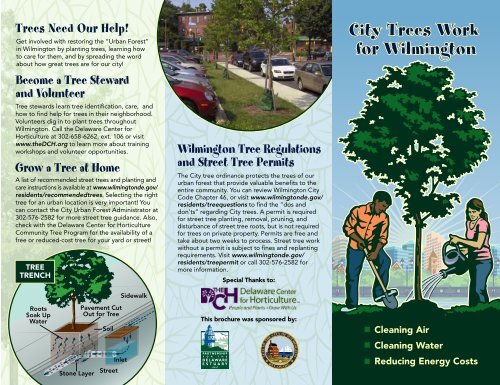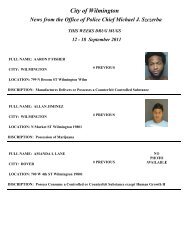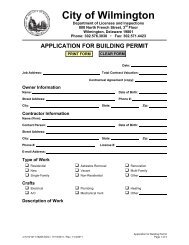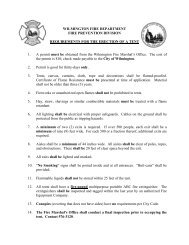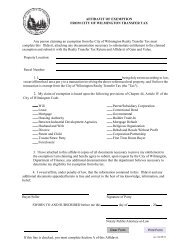CityTreesWorkForWilm.. - City of Wilmington, Delaware
CityTreesWorkForWilm.. - City of Wilmington, Delaware
CityTreesWorkForWilm.. - City of Wilmington, Delaware
Create successful ePaper yourself
Turn your PDF publications into a flip-book with our unique Google optimized e-Paper software.
Trees Need Our Help!<br />
Get involved with restoring the “Urban Forest”<br />
in <strong>Wilmington</strong> by planting trees, learning how<br />
to care for them, and by spreading the word<br />
about how great trees are for our city!<br />
Become a Tree Steward<br />
and Volunteer<br />
Tree stewards learn tree identification, care, and<br />
how to find help for trees in their neighborhood.<br />
Volunteers dig in to plant trees throughout<br />
<strong>Wilmington</strong>. Call the <strong>Delaware</strong> Center for<br />
Horticulture at 302-658-6262, ext. 106 or visit<br />
www.theDCH.org to learn more about training<br />
workshops and volunteer opportunities.<br />
Grow a Tree at Home<br />
A list <strong>of</strong> recommended street trees and planting and<br />
care instructions is available at www.wilmingtonde.gov/<br />
residents/recommendedtrees. Selecting the right<br />
tree for an urban location is very important! You<br />
can contact the <strong>City</strong> Urban Forest Administrator at<br />
302-576-2582 for more street tree guidance. Also,<br />
check with the <strong>Delaware</strong> Center for Horticulture<br />
Community Tree Program for the availability <strong>of</strong> a<br />
free or reduced-cost tree for your yard or street!<br />
TREE<br />
TRENCH<br />
Sidewalk<br />
<strong>Wilmington</strong> Tree Regulations<br />
and Street Tree Permits<br />
The <strong>City</strong> tree ordinance protects the trees <strong>of</strong> our<br />
urban forest that provide valuable benefits to the<br />
entire community. You can review <strong>Wilmington</strong> <strong>City</strong><br />
Code Chapter 46, or visit www.wilmingtonde.gov/<br />
residents/treequestions to find the “dos and<br />
don’ts” regarding <strong>City</strong> trees. A permit is required<br />
for street tree planting, removal, pruning, and<br />
disturbance <strong>of</strong> street tree roots, but is not required<br />
for trees on private property. Permits are free and<br />
take about two weeks to process. Street tree work<br />
without a permit is subject to fines and replanting<br />
requirements. Visit www.wilmingtonde.gov/<br />
residents/treepermit or call 302-576-2582 for<br />
more information.<br />
Special Thanks to:<br />
<strong>City</strong> Trees Work<br />
for <strong>Wilmington</strong><br />
Roots<br />
Soak Up<br />
Water<br />
Pavement Cut<br />
Out for Tree<br />
Soil<br />
This brochure was sponsored by:<br />
Cleaning Air<br />
Cleaning Water<br />
Stone Layer<br />
Street<br />
Inlet<br />
Reducing Energy Costs
Trees Work Hard<br />
Every Day to<br />
Improve Our<br />
Quality <strong>of</strong> Life:<br />
Trees pull carbon dioxide<br />
and other pollutants out<br />
<strong>of</strong> the air as they grow, and<br />
then release oxygen to help us all<br />
breath a little easier.<br />
Mature trees soak up 50–100 gallons <strong>of</strong> water<br />
during wet weather and tree roots help to direct<br />
more water into the ground. This reduces the<br />
amount <strong>of</strong> stormwater that floods our streets<br />
and pollutes our creeks and rivers.<br />
Large trees provide cool shade for buildings<br />
and reduce air conditioning energy costs. In<br />
winter months, trees can block wind to reduce<br />
heating costs.<br />
A large covering <strong>of</strong> trees can absorb humidity and<br />
reduce the air temperature by 5–10 degrees F —<br />
making it much more comfortable outside on a<br />
hot day.<br />
Shaded roads and sidewalks require less pavement<br />
maintenance, saving up to 60% in repair costs<br />
over non-shaded streets.<br />
Trees increase property values and business<br />
revenues. Studies have shown that people are<br />
willing to pay more money to live, work,<br />
and shop in communities with trees.<br />
Green areas beautify our neighborhoods<br />
and provide a place for relaxation and<br />
recreation, while reducing stress and<br />
promoting better moods and physical health.<br />
Trees provide shelter for birds and other small<br />
animals while reconnecting people to the<br />
natural environment.<br />
Benefits <strong>of</strong> Trees<br />
Bigger trees naturally provide bigger benefits,<br />
but some locations may require a smaller tree.<br />
At any size, street trees in <strong>Wilmington</strong> are<br />
worth planting and protecting.<br />
Here are examples <strong>of</strong> both<br />
large and small tree benefits<br />
(from the National Tree<br />
Benefit Calculator on<br />
www.arborday.org):<br />
SHINGLE OAK<br />
(40-65’ tall)<br />
In one year, a mature<br />
Shingle Oak tree will:<br />
Reduce carbon<br />
dioxide and other<br />
air pollutants by<br />
954 pounds.<br />
Soak up 16,401 gallons<br />
<strong>of</strong> stormwater run<strong>of</strong>f.<br />
Save 386 Kilowatt/hours<br />
<strong>of</strong> electricity for cooling<br />
and reduce use <strong>of</strong> oil or<br />
natural gas by 900 cubic feet.<br />
AMERICAN HORNBEAM<br />
(25-35’ tall)<br />
In one year, a mature American<br />
Hornbeam will:<br />
Reduce carbon dioxide and<br />
other air pollutants by 801<br />
pounds.<br />
Soak up 2,878 gallons <strong>of</strong><br />
stormwater run<strong>of</strong>f.<br />
Save 114 Kilowatt/hours <strong>of</strong><br />
electricity for cooling and<br />
reduce use <strong>of</strong> oil or natural<br />
gas by 400 cubic feet.<br />
What Exactly is a Street Tree?<br />
A street tree is a tree located within the public<br />
right-<strong>of</strong>-way. Right-<strong>of</strong>-way widths vary by street,<br />
so it is not always clear which trees are street trees.<br />
Listed below are three general location categories<br />
defining a street tree that requires a permit for<br />
planting, removal and pruning:<br />
1.<br />
2.<br />
3.<br />
A tree pit – a square or rectangle cut out <strong>of</strong><br />
the pavement between the curb and<br />
sidewalk.<br />
A tree lawn – the area between the curb<br />
and sidewalk usually planted with trees,<br />
grass and other landscaping.<br />
Trees in the area behind a sidewalk, closer<br />
to private property, MAY be considered<br />
street trees.<br />
Every dollar<br />
invested in tree planting<br />
and care is naturally returned<br />
to us in life-improving benefits.<br />
Over 40 years, 100 large<br />
public trees total:<br />
Benefits.....................$587,360<br />
Costs.........................$134,280<br />
40-year net benefit...$453,080<br />
Source: U.S. Forest Service


